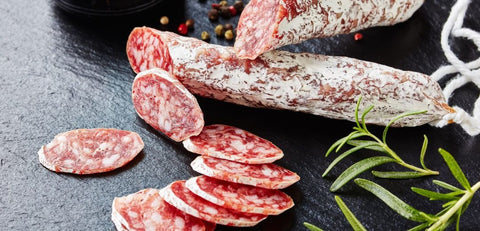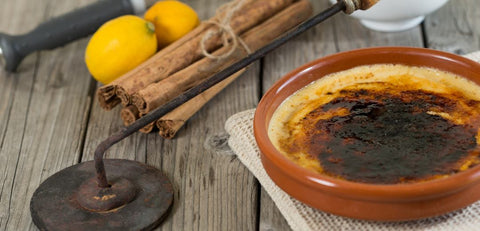Fuet, a cured sausage originating from Catalonia, has long been a staple in the region. Over the past 40 years, its popularity has surged across Spain, making it a household favorite for everyday enjoyment.
However, numerous questions often arise regarding fuet. These range from basic queries about what fuet is, to more nuanced inquiries about its white coating, whether it should be eaten with or without its skin, the differences between fuet and similar sausages like espetec or salchichón, and the ideal way to slice it. Even avid fuet enthusiasts may find some of these questions challenging. Therefore, this article aims to provide quick and incredibly useful answers to these common queries, enhancing your knowledge for the next family breakfast or appetizer.
What is Fuet?
Fuet is a type of cured sausage primarily made from lean pork meat. Once cured and dried, it is typically consumed raw, sliced thinly. It's commonly enjoyed with tomato bread (either as a sandwich or toast) or as a tapa, often accompanied by olives or potatoes.
The term "fuet" comes from the Catalan language, meaning "whip," reflecting its long, thin shape. Despite its whip-like appearance, rest assured, it's not used for anything other than culinary delight. Fuet is steeped in a rich history of artisanal craftsmanship, with some producers crafting it for over a century and a half.
Fuet's Origins
Fuet is most popular in Catalonia, its place of origin. It's particularly renowned in the Catalonian towns of Vic, the capital of the Osona region, and Olot, the capital of the La Garrotxa region.
Traditionally, fuet was made in rural homes during the annual pig slaughter. Part of the pork meat was stuffed into the animal's intestines, then salted and dried, to preserve the meat for longer periods.
The White Coating on Fuet
Perhaps the most distinctive feature of fuet, as well as other similar sausages like salchichón or secallona, is the white mold that coats its surface. This mold is deliberately cultivated during the drying stage to prevent undesirable molds that could spoil the sausage, while also adding extra flavor and aroma.
There are two primary methods of cultivating this mold:
- Natural Method: Requires a curing chamber already containing the desired fungus. The fuet is placed inside, allowing the fungus to contact and grow on it. However, this method doesn't allow for control over the fungus.
- Artificial Method: In a sterile curing chamber, the fuet is coated in a liquid containing fungus spores before drying. This method allows for controlled mold growth using temperature and humidity adjustments.
The most commonly used fungi for this process are from the genus penicillium, specifically penicillium nalgiovense and penicillium chrysogenum, with the former being more prevalent.
Contrary to what it might seem, this mold is not flour, making fuet safe for those with gluten intolerance or celiac disease.
To Peel or Not to Peel?
Whether to eat fuet with its skin on is a matter of personal preference.
You don't have to peel fuet. The skin is part of the sausage itself, being natural and edible. Today, almost all fuet is encased in natural pork intestines, making the skin completely safe to consume.
However, a small percentage of fuet may have synthetic skin, made from collagen, cellulose, or plastic, often used in lower-grade products. Whether this synthetic skin is edible should be indicated on the label, but such products are generally not recommended for various reasons.
How to Slice Fuet
The preference for thin or thick slices of fuet also varies. Some prefer thin slices to enjoy its delicate flavors, while others opt for thicker cuts for a more robust taste experience.
Differences Between Fuet and Salchichón
Fuet and salchichón are both popular Spanish sausages, but they have distinct characteristics that set them apart. Understanding these differences can enhance your appreciation of these culinary delicacies.
Size and Thickness
One of the most noticeable differences between fuet and salchichón is their size. Fuet is a thinner sausage, typically measuring about 3 to 4 centimeters in diameter. In contrast, salchichón is much thicker, with a diameter ranging from 5 to 10 centimeters.
Weight and Curing Time
The difference in thickness directly impacts two other aspects: weight and curing time. A piece of fuet generally weighs around 200 grams, whereas salchichón can easily weigh 500 grams or more. Due to its thickness, salchichón requires a longer curing time compared to fuet. Typically, fuet is cured for about two weeks, while salchichón needs around four weeks to properly cure.
Composition and Seasoning
Although both sausages share similar ingredients, there are slight variations in their compositions. Salchichón usually contains more seasoning, especially black pepper, which gives it a distinct flavor profile compared to fuet.
Slicing
In culinary practices, salchichón is often sliced thinner than fuet. This finer slicing is in part due to its thicker diameter and more robust flavor, which can be better appreciated in thinner slices.
Conclusion
Both fuet and salchichón are cherished components of Spanish cuisine, each with its unique attributes. Whether it's the thin, subtly flavored fuet or the thick, richly seasoned salchichón, these sausages continue to be a testament to the rich culinary history and diversity of Spain. Understanding their differences not only enriches the dining experience but also deepens one’s appreciation for the art of traditional sausage making





